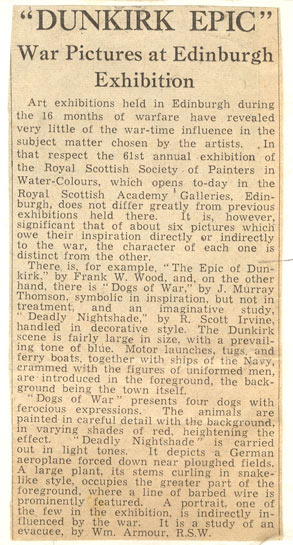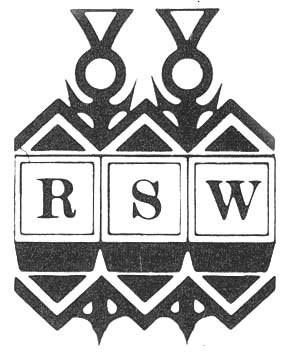War Pictures at Edinburgh, Exhibition
 Art exhibitions held in Edinburgh during the 16 months of warfare have revealed very little of the war-time influence in the subject matter chosen by the artists. In that respect the 61st annual exhibition of the Royal Scottish Society of Painters in water-colours, which opens to-day in the Royal Scottish Academy Galleries, Edinburgh, does not differ greatly from previous exhibitions held there. It is, however, significant that of about six pictures which owe their inspiration directly or indirectly to the war, the character of each one is distinct from the other.
Art exhibitions held in Edinburgh during the 16 months of warfare have revealed very little of the war-time influence in the subject matter chosen by the artists. In that respect the 61st annual exhibition of the Royal Scottish Society of Painters in water-colours, which opens to-day in the Royal Scottish Academy Galleries, Edinburgh, does not differ greatly from previous exhibitions held there. It is, however, significant that of about six pictures which owe their inspiration directly or indirectly to the war, the character of each one is distinct from the other.
There is, for example, “The Epic of Dunkirk”, by Frank W. Wood, and, on the other hand, there is “Dogs of War”, by J. Murray Thomson, symbolic in inspiration, but not in treatment, and an imaginative study, “Deadly Nightshade”, by R. Scott Irvine, handled in decorative style. The Dunkirk scene is fairly large in size, with a prevailing tone of blue. Motor launches, tugs, and ferry boats, together with ships of the Navy, crammed with the figures of uniformed men, are introduced in the foreground, the background ground being the town itself.
“Dogs of War” presents four dogs with ferocious expressions. The animals are painted in careful detail with the background, in varying shades of red, heightening the effect. “Deadly Nightshade” is carried out in light tones. It depicts a German aeroplane forced down near ploughed fields. A large plant, its stems curling in snakellike style, occupies the greater part of the foreground, where a line of barbed wire is prominently featured. A portrait, one of the few in the exhibition, is indirectly influenced by the war. It is a study of an evacuee, by William Armour, RSW.
